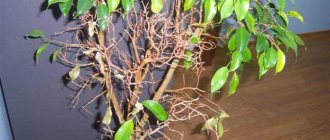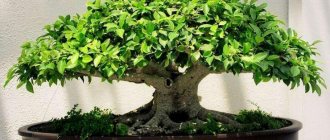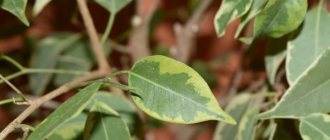Ficus benjamina should form a beautiful tree. Numerous photos show compact, attractive plants with a dense crown, but what is really happening? Left unattended bushes are one-sided, elongated, with bare trunks, causing sadness. Regular pruning and shaping of Ficus Benjamin should become as common an element of home care as watering or fertilizing. Only then will he be truly attractive.
Why is pruning needed?
To keep the ficus crown fluffy, it is periodically pruned. The operation is performed according to certain rules. Pruning Ficus Benjamin at home is the main stage of caring for the plant and makes it possible to form a tree of the desired configuration.
Young plant
Features of the process are associated with the development of ficus. Its branches develop from shoots, which in turn are formed from buds. The kidneys themselves come in two types:
- Growing from the top of the trunk and ensuring the growth of the plant in height.
- Side shoots giving crown density. They are located along the entire trunk.
The rapid development of the upper buds leads to the fact that the ficus grows intensively. When they are removed, side shoots begin to grow, making it branchy and lush.
Tiered standard
Tiered trunk is a form of tree with a crown divided into parts. Between its tiers there remains a bare trunk without branches. Such a tree can have 2 or more tiers.
Sometimes tiers are built up gradually . First, a regular standard tree with a round or oval crown is formed. Then pruning is carried out in such a way that the central shoot grows upward.
Gradually, it will be possible to form a continuation of the trunk, and then a new tier of the crown. This is the longest process of forming a longline trunk.
It is much faster to plant 2 cuttings at once and fasten their trunks with wire. Gradually, below they will grow together into a single trunk. The plants will be separated at the top.
Each of them can be grown as a regular standard, but their crowns will be at different heights. If you plant cuttings with different leaf colors, you can get a very beautiful tree with different colors of the crown tiers.
A tiered trunk can be grown from one cutting . It should grow upward, forming an elongated tall single trunk. After the formation of the lower part of the trunk, its crown must be divided into 3 parts.
The lower and upper parts will be two tiers of the trunk, the central part will be the bare trunk located between them. In the center, all side shoots are removed and the top of the tree is pinched. The tiers are formed like a regular single trunk.
Trimming time and tool preparation
Weaving ficus benjamina at home
Spring is a time of active growth, while with the onset of cold weather the process slows down. Pruning is best done in the warmer months.
Note! Pruning in autumn or winter can lead to improper formation of the crown and deformation of the trunk.
Shaping and pruning the ficus crown is carried out when the trunk is still young and not woody. Subsequently, such interference can become fatal for the plant, and if it survives, it will take a long time to regain its strength.
For proper pruning prepare:
- pruner;
- sterile napkin;
- activated or charcoal;
- a disinfectant such as medical alcohol or a weak solution of potassium permanganate.
Before starting work, the pruning shears are disinfected so as not to infect the plant when making a cut.
General rules for pruning Ficus Benjamin
Flower growers advise pruning Ficus Benjamin for the following purposes:
- To rejuvenate the plant. After the procedure, the trunk and branches begin to actively grow, which has a positive effect on the maturation of the ficus.
- Improvements in appearance. You can create a design for a specific room.
- Stimulating branching. If the procedure is carried out correctly, it is possible to simulate how and in what quantity the branches will grow, as well as their size in the future.
- Sanitary treatment of plants. During the growth process, dry and infected shoots are removed.
Transplanting Ficus Benjamin at home
The formation of a lush crown is achieved by pinching off a shoot growing at the very top of the trunk. It is called the growth point. It is better to do this one or two weeks before the transplant. Active growth requires a greater need for nutrients, so fertilizing is necessary.
Important! It is impossible to prune and replant the plant at the same time, as this will lead to its death. The flower will not have time to recover.
How to prune ficus benjamina? Step-by-step method for pruning Ficus Benjamin:
- Prepare the plant for the procedure, clean and water it.
- Use pre-disinfected garden tools.
- The cut on thin branches is made straight, and thick ones are shortened obliquely.
- At the end of the procedure, the instrument is disinfected by treating the sections with wood ash. Before this, remove the juice with a napkin.
- When starting to form the crown, they focus on the natural silhouette.
- Each movement of the scissors must be precise so that in the end the ficus becomes a beautiful and not a plucked flower.
- Branches that spoil the appearance of the plant are removed.
- The upper shoots and branches growing parallel to the trunk are cut off.
At home, crown formation is carried out until the flower reaches three years of age. If the plant is sick, it is better to postpone the pruning procedure for some time.
Plant pruning
Sculpture
It is very difficult to grow a crown in the form of a sculpture; work on it takes a long time.
Only an experienced gardener can create a tree in the shape of an animal or bird. It is easier to make the crown in the form of a geometric figure - a cone or cylinder. Even the formation of a simple geometric crown takes several years.
In this case, it is necessary to prune the plant annually in the spring, cutting off the branches so that the crown takes on the desired shape.
Usually the branches directed outward are left, and the crowns growing deeper are cut out.
At the same time, the outer part of the crown branches out greatly, so it becomes easier to give it the desired shape.
Pruning to rejuvenate the plant
How to feed ficus benjamina at home
The procedure is carried out to make the tree more attractive and lush. When rejuvenating pruning, shoots that are too long and crooked are removed, as well as branches that have begun to dry out and have dropped their leaves.
Additional Information! To speed up the restoration of plants, the soil is fertilized. Old branches are removed completely, and young ones are shortened. The work is carried out during the rest period, when the ficus does not bloom.
How to rejuvenate an adult specimen?
A beautiful large tree has lost its leaves and dried up? Don't rush to throw it away. Understand the reasons for this behavior. If the reason is a long dry period or the influence of low temperatures, then the tree can be saved. It is necessary to provide him with optimal temperature conditions and good living conditions. Cut off all dried branches at the root. Or remove all the growth altogether so that young growth grows in its place. The plant will be able to recover due to its developed root system. However, this method will not work if it is the roots that are initially damaged. And it was because of their illness that the leaves fell.
For experiments, it is better to choose a young ficus Benjamin. Forming the crown (photo below) of adult specimens is more difficult to carry out. They do not grow green mass so quickly. There is no question at all about intertwining thick trunks or splicing them.
You need to start giving the ficus an aesthetic appearance from the moment of purchase. Always use clean, disinfected tools for shaping. And in order for the foliage to grow quickly and please the eye, the ficus needs to be provided with good conditions for growth and development.
Sanitary pruning
Proper care of a flower requires not only watering and feeding it on time, but also protecting it from diseases by sanitary pruning. In this case, you can give the crown the desired shape. The procedure has the following goals: removal of dried, yellowed or infected branches and leaves; ridding the trunk of crooked and affected shoots.
The damaged part of the plant is removed to the base, this will reduce the risk of spreading the infection. If part of the root is affected, then cut it off with a piece of healthy tissue and do not forget to treat the problem area with disinfecting compounds. This will protect the flower from death.
Inspection for sanitary pruning
Formation of a beautiful crown and general appearance
Creating the desired crown shape begins with modeling the location and density of the upper and lateral shoots.
There are several crown options:
- Bush-like. Take a ficus whose age does not exceed two years, and pinch the top shoot at a height of 10-15 cm. The lateral buds that give growth are not affected. The procedure is repeated as the tree grows. With repeated manipulations, excess shoots are removed, which give unnecessary density and interfere with the normal development of other branches. To ensure uniform growth, the pot is periodically turned on the windowsill to ensure even access to sunlight.
- Crown Stamb. Its formation begins almost immediately after planting the ficus. For modeling, about five healthy buds are left on the trunk, and the rest are completely removed. When the height of the plant exceeds forty centimeters, the top is pinched. Gradually, the silhouette of a palm tree begins to form from leaves on a long and beautiful trunk. Periodically thin out the branches and turn the plant with different sides towards the light.
- Crown Tier. They are created from an already formed standard plant, in which the top is not cut off immediately, but grows another ten centimeters and only then is pinched. Side branches from the lower tier are removed completely, as well as shoots that create excessive crown density.
The beginning of bush formation
Error correction
Sometimes, when forming the desired shape or type, the gardener makes a number of mistakes or fails to achieve the desired shape; in such cases, it is worth exploring ways to correct the appearance of the ficus:
- In the case of one-sided growth, in order to increase the intensity of growth of the lateral buds, it is necessary to carry out the coring procedure (light incision of the woody bark above the sprout). Kerbovanie is carried out with a sharp and sterile object (blade, knife, scissors or scalpel). By making a cut above the shoot, the grower thereby stimulates growth in an already woody area;
- Modeling the growth of branches with your own hands. If there are obvious imperfections in the indoor tree, you can set the direction of growth of the branches with your own hands, or tie them with ropes to the fastenings;
- Treatment with cytoxins (growth hormones) promotes artificial growth of ficus, as well as slowing down all aging processes in the trunk;
- If the crown develops unevenly, they resort to vaccinations. Both individual shoots and entire branches of the desired shape can be grafted onto ficus trees. What is a vaccination? This is a “plant surgery”, i.e. transplantation (transplantation) of one part of a plant (from one species) to another. To carry out the grafting, you need to cut off the desired part from one ficus and transplant it to another, using a scalpel (another sharp object) and a dressing tape (gauze or a piece of polyethylene). The required part is cut off from the donor plant and carefully attached to another (but which has already been made the same incision). After the procedure, the transplant site is bandaged with tape.
Root pruning
Sometimes it is recommended to remove not only the branches, but also the roots of the plant, which interfere with development. This type of work requires care and caution, as the health of the flower depends on this. Usually the root is removed when it is infected and the ficus requires replanting:
- After cleaning the soil, the roots are placed in an antiseptic solution.
- Then the injured and interfering processes are removed.
- The sections are sprinkled with activated carbon dust.
- Plant the ficus in another container.
Useful tips for growing
- When pruning ficus, do not leave stumps - fungi can grow in them.
- Wipe the area of the fresh cut with a damp cloth until the juice flow stops.
- Immediately after finishing work, wipe tools stained with ficus milk with a cloth soaked in alcohol.
- Flower shops sell special vaccinations that stimulate the growth of ficus.
- If ficus juice gets on your body, rinse the area thoroughly with water.
Creating unusual shapes
There are many options for creating interesting ficus shapes. Flower growers are attracted to forms in the form of a spiral or a fence; someone may be interested in a braided braid. To do this, plant the sprouts in strict sequence. The result of painstaking work will delight you with unusual beauty if you use the right preparation scheme.
Beautiful braid
Activities after pruning
After pruning, experts recommend taking several additional actions to promote the rapid development of the plant after stress. Using a sterile napkin, remove all the milk that will be released by the sections. This must be done until the surface is completely dry. Remove the flower away from the bright sun. Water the plant strictly according to schedule, avoiding stagnation of water. Feeding is carried out, but not earlier than a few weeks after pruning.
Important! Watering is carried out with settled water at room temperature. The leaves are wiped with a damp cloth.
When pruning, watch your movements so as not to cause wounds. This can cause the ficus to become infected, weaken its strength and even destroy the flower.
Pruning ficus benjamina is not difficult, but after that you should properly care for it. It is better to choose warm months for the procedure, but if the need arises, November is suitable for this purpose. With proper pruning, you can get an interesting looking flower that will decorate your home.
Top dressing
Ficus benjamina needs regular feeding, which helps the plant to actively grow and develop. Fertilizers are applied throughout the growing season with the following frequency:
- in March and April – once a month;
- in May - once every three weeks;
- from June to September - once every two weeks.
If in winter the ficus continues to develop under optimal conditions, you should not stop feeding. Fertilizers are applied once every two months, diluted by half the dosage indicated in the instructions. If the room temperature is low, there is little light, and the ficus has stopped growing, stop feeding it.
Ficus responds well to both mineral and organic fertilizers, which are recommended to be alternated. Mineral fertilizers can be purchased in specialized stores. For ficus, complexes intended for decorative deciduous plants are suitable, since they contain elements that favorably influence the development of green mass.
Suitable organic fertilizers include: chicken manure, ash, sapropel. Chicken manure is considered one of the best organic fertilizers because it contains a large amount of nitrogen. How to add droppings to a ficus benjamina pot? First you need to prepare a solution: add five grams of rotted droppings per liter of water and stir well until a homogeneous mass of light green color is obtained. You can water the plant with a solution containing chicken droppings only after abundantly moistening the soil with plain water (this rule applies when applying any fertilizers).











